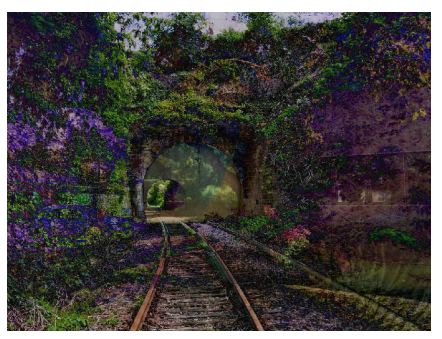Federal Court Rules Work Generated by Artificial Intelligence Alone Is Not Eligible for Copyright Protection
As more individuals and businesses are seeking to take advantage of artificial intelligence to generate written and visual content, it is important to understand the scope of copyright protection that might ultimately be afforded to that content. On 18 August 2023, in Thaler v. Perlmutter, Case No. 1:22-cv-01564, (D.D.C. 2022), the United States District Court for the District of Columbia confirmed that artwork generated autonomously by artificial intelligence (AI) alone is not entitled to protection under the Copyright Act. This first-of-its-kind federal court ruling sets the baseline for those seeking to secure ownership and copyright protection for AI-generated content.
Prior Application for Copyright Registration
The case arises out of Stephen Thaler’s 3 November 2018 copyright application for the below-pictured two-dimensional image entitled “A Recent Entrance to Paradise,” which depicts a set of train tracks running through a lush countryside:

Source: Second Request for Reconsideration for Refusal to Register A Recent Entrance to Paradise (Copyright Review Board, Feb. 14, 2022).
Mr. Thaler’s application for copyright registration, which is discussed in this earlier blog post, listed the author of the work as the “Creativity Machine,” “a computer algorithm running on a machine,” which autonomously created the image. Mr. Thaler did not claim he had any role in the creation of the image, except that he owned the Creativity Machine and was “seeking to register this computer-generated work as a work-for-hire.” In a 12 August 2019 letter, the Copyright Office denied his application, because the work “lacks the human authorship necessary to support a copyright claim.” In a request for reconsideration, Mr. Thaler challenged the human authorship requirement as “unconstitutional and unsupported by either statute or case law.” Upon reconsideration, the Copyright Office did not find his challenge persuasive.
On 27 May 2020, Mr. Thaler filed a second request for reconsideration arguing that granting copyright registration for AI-generated works would “further the underlying goals of copyright law, including the constitutional rationale for copyright protection” and should be permitted under the work-made-for-hire doctrine which has allowed non-human corporate entities to own copyrighted works created by their employees or pursuant to a written agreement. This second request was also unsuccessful, and the Copyright Office maintained its original decision to deny registration.
Human Authorship Requirement Affirmed
In its letter denying Mr. Thaler’s second request, the Copyright Office affirmed its opinion that the Copyright Act provides protection only to human “authors” and analogized AI-generated work to other works created by non-human authors that were denied registration in the past, such as holy or spiritual songs authored by the “holy spirit” or other “divine beings,” even when working through a human vessel; pictures taken by a monkey who found and made use of a camera; or a “living garden” that was created by nature or “natural forces,” as opposed to human ingenuity. The Copyright Office rejected Mr. Thaler’s work-made-for-hire argument on the same basis, explaining that while the doctrine does allow a human author to vest ownership of a copyright in a corporate, non-human employer via contract, it does not imply that the employer created the copyrighted work. Moreover, the Copyright Office explained that AI is not a legal entity that could enter into such a contract or be considered an “employee.”
After exhausting his administrative remedies, Mr. Thaler filed suit against the Copyright Office, asking that its decision denying registration be reversed as arbitrary and capricious, in violation of the Administrative Procedure Act. Granting the Copyright Office’s motion for summary judgment, the Court affirmed that “human creativity is the sine qua non at the core of copyrightability, even as that human creativity is channeled through new tools or into new media.” The human authorship requirement, the Court went on to explain, “follows from the plain text of the Copyright Act,” which provides protection only for works done “by or under the authority of [an] author,” meaning “an originator with the capacity for intellectual, creative, or artistic labor.” The Court declined to “delv[e] into th[e] debate” over whether non-humans may be covered by the Copyright Act, suggesting that it is academic in the face of “centuries of settled understanding” that authors are “presumptively” human.
That decision is also consistent with the longstanding position of the US Copyright Office that a copyright requires human authorship. US Copyright Office, Compendium of US Copyright Office Practices § 313.2 (3d ed. 2017) (“To qualify as a work of ‘authorship’ a work must be created by a human being”). As a result, the US Copyright Office will not register works produced by a machine “automatically without any creative input or intervention from a human author.”
Other Arguments Unavailing
The Court also rejected Mr. Thaler’s argument that granting registration to AI-generated work would further the underlying goals of the Copyright Act to incentivize creativity, science, and the useful arts, concluding that “[n]on-human actors need no incentivization with the promise of exclusive rights under United States law.” Noting that the scope of its review was limited only to the question of whether “a work generated entirely by an artificial system absent human involvement should be eligible for copyright,” the Court also declined to address Mr. Thaler’s other “legal theories under which a copyright in the computer’s work would transfer to him, as the computer’s owner; for example, by operation of common law property principles or the work-for-hire doctrine.” In dicta, however, the Court indicated its agreement with the Copyright Office’s position that AI cannot be considered an “employee” subject to the work-for-hire doctrine, nor could it transfer a copyright that it could not author in the first place.
Conclusion and Future Cases
In its decision, the Court recognized its review was limited to the administrative record before it. The Court noted that facts related to Mr. Thaler’s “development, use, ownership, and prompting of the AI generating software in the so-called ‘Creativity Machine,’ implying a level of human involvement” were “entirely absent in the administrative record.” Thus, the Court focused on the narrow question of whether any work would be eligible for copyright “[i]n the absence of... human involvement in the creation of the work” and responded with “the clear and straightforward answer... : “No.”” In doing so, Court avoided the “challenging questions” regarding “how much” human involvement is necessary, the appropriate scope of copyright protection that should be granted to AI-generated works, “how to assess the originality of AI-generated works,” and how to best incentivize the creative use of AI, and instead left the door open for future cases to addresses these questions with respect to the copyrightability of AI-generated work.
This publication/newsletter is for informational purposes and does not contain or convey legal advice. The information herein should not be used or relied upon in regard to any particular facts or circumstances without first consulting a lawyer. Any views expressed herein are those of the author(s) and not necessarily those of the law firm's clients.









